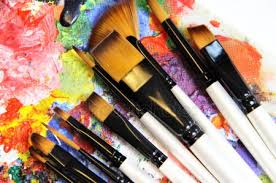RUSSIAN Vanguard. MAIN DIRECTIONS (part 3)
 Abstractionism (abstract art).
Abstractionism (abstract art).
The main theorists and practitioners were V. Kandinsky, P. Mondrian. Abstractionism rejected the image of forms of visually perceived reality, from isomorphism and focused solely on the expressive, associative, synesthetic properties of color, non-isomorphic abstract color forms and their innumerable combinations. The first abstract works were created in 1910 by Kandinsky. He set forth the aesthetic creed of abstract art in his book On the Spiritual in Art (1910) and in a number of other books and articles. Its essence boils down to the fact that the rejection of the image of external, visible forms of objects allows the artist to focus on solving exclusively pictorial problems of harmonizing color and form, through which the spiritual cosmos comes into contact with the recipient. In fact, Kandinsky at a new level returns to the ideas of Platonic-Neoplatonic aesthetics. He likens the painting to music in its absolute meaning, and he sees its main purpose in expressing on the canvas or a sheet of paper the music (sound) of the objectively existing “Spiritual”. The artist, in the understanding of Kandinsky, is only an intermediary of the Spiritual, a tool with which it materializes in artistic forms. Therefore, abstract art is not an invention of contemporary artists, but a historically natural form of the Spiritual expression, adequate to its time. Dutch spiritual Mondrian, one of the largest representatives of its “geometric” direction, was connected with spiritual cosmic forces.
Abstract art developed in two main directions: harmonization of amorphous color combinations; creating geometric abstractions. The first direction (the main representatives – early Kandinsky, F. Kupka) brought to a logical conclusion the search for the Fauvists and Expressionists in the field of “liberating” colors from forms of visible reality. The main emphasis was placed on the independent expressive value of color, its coloristic richness and synesthetic overtones, on the musical associations of color combinations, through which art sought to express the deepest “truths of life”, eternal “spiritual essences”, the movement of “cosmic forces”, as well as lyricism and the drama of human experiences, the intensity of spiritual quests, etc. The second direction developed along the path of creating new types of art space by combining all kinds of geometric shapes , color planes, combinations of straight and broken lines. Its main representatives were Malevich of the period of geometric suprematism, members of the Dutch group “De Steil” (since 1917), led by Mondrian and T. Van Dusburg, the late Kandinsky with his geometric abstract compositions. The Dutch put forward the concept of neoplasticism, which contrasted with “chance, uncertainty and the arbitrariness of nature”, “simplicity, clarity, constructiveness, functionality” of pure geometric forms, expressing, in their opinion, the cosmic, divine laws of the Universum (Van Dusburg). The mystical simplicity of the horizontal-vertical opposition, according to Mondrian, which became the basis of all his work in the mature period, using certain local colors gives endless possibilities for achieving visual proportions and balance, which have a spiritual and ethical essence. For the first time in the history of art, Mondrian and his colleagues managed to achieve a balance of artistic masses using asymmetric constructions, which gave a powerful impetus to architecture, applied art, and design of the 20th century. direct direct deep contact with purely spiritual spheres. In this regard, many works of abstractionism (especially the work of Kandinsky, Malevich, M. Rothko, partly Mondrian) can serve as objects of meditation and mediators in other spiritual practices. It was not by chance that Malevich felt in his works proximity to the Russian icon (see: Icon), and behind his Black Square the reputation of the “icon of the twentieth century” strengthened. The designation, given initially with a derogatory-ironic connotation, well expressed the essence of this phenomenon.
Suprematism
Suprematism (from lat. Supremus – the highest) is one of the areas of abstract painting, created in the mid-1910s. K. Malevich. The goal of Suprematism is the expression of reality in simple forms (straight, square, triangle, circle) that underlie all other forms of the physical world. In Suprematist paintings there is no idea of “top” and “bottom”, “left” and “right” – all directions are equal, as in outer space. The space of the picture is no longer subject to gravity (up-down orientation), it has ceased to be geocentric, that is, a “special case” of the universe. An independent world arises, enclosed in itself, and at the same time correlated as equal with universal world harmony.




